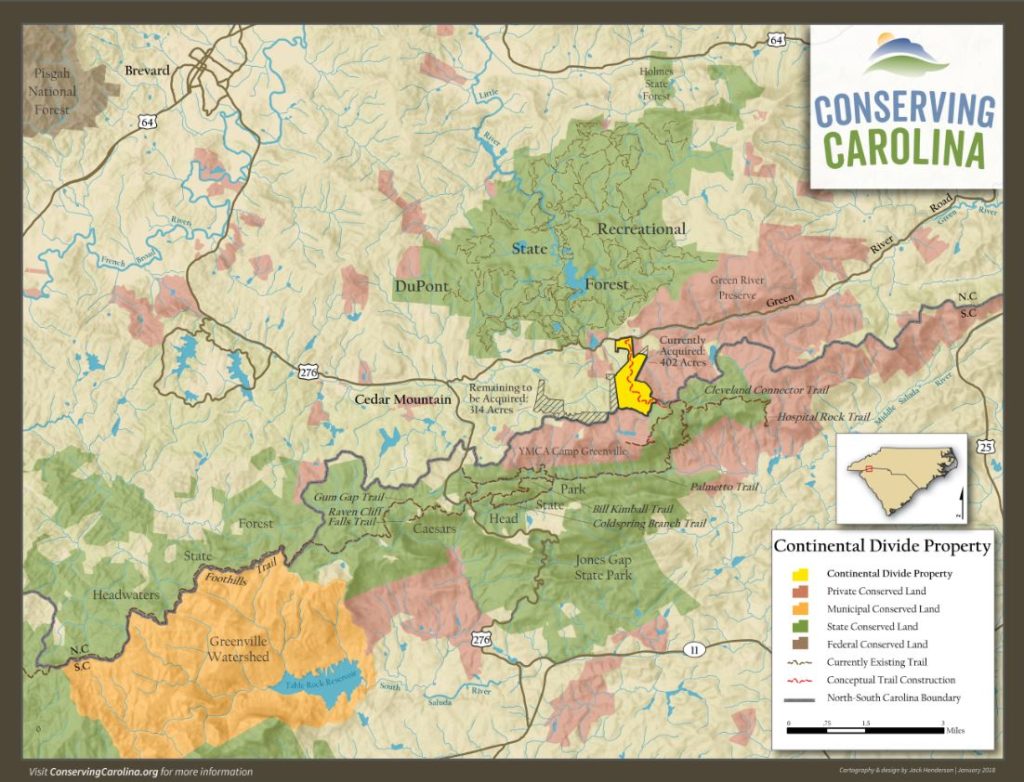402 Acres Added to DuPont State Recreational Forest

Continental Divide Tract Helps Link State Forest to Vast Conservation Corridor
On Tuesday, February 12, Conserving Carolina transferred 402 acres of land to the North Carolina Forest Service to expand Dupont State Recreational Forest (DSRF). This tract helps to conserve key headwater streams along the Eastern Continental Divide.
Update: In May 2019, we completed phase 3 of our purchase, protecting another 315 acres. Our goal is to convey this tract to DuPont State Recreational Forest as well.
“In a region blessed with an abundance of public and conserved natural lands, DuPont State Recreational Forest is already one of our greatest conservation gems,” said Conserving Carolina executive director Kieran Roe. “The incorporation of the Continental Divide tract will enhance it further by protecting water quality, preserving an important wildlife corridor and creating future opportunities for public recreation.”
The Continental Divide tract located south of DSRF in Transylvania County helps link the state forest to the Eastern Continental Divide, which separates the waters that flow east toward the Atlantic from those that flow west toward the Gulf of Mexico. It also helps link DSRF to over 100,000 acres of existing conserved lands along the North Carolina-South Carolina state line. These public lands include Jones Gap State Park, Caesar’s Head State Park, Mountain Bridge Wilderness Area, Headwaters State Forest, Greenville Watershed, Jocassee Gorges, and Gorges State Park—and, further west, Sumter and Nantahala National Forests. The Continental Divide property also borders thousands of acres of private conservation land, including two summer camps.
“DuPont State Recreational Forest is an incredible natural resource that we are fortunate as a state to have,” said N.C. Agriculture Commissioner Steve Troxler. “I am proud this new tract will add to the N.C. Forest Service’s continued efforts to protect and improve renewable and valuable natural resources, including critical headwaters. Water quality affects us all, and now this resource will be there for future generations as well.”
Streams located on the Continental Divide tract form the headwaters of both Reasonover Creek and the Green River. The extended conservation area where the land is located allows wildlife access to a vast migration corridor, enabling fauna to seek out food, shelter and mates. The location of the corridor along the Blue Ridge Escarpment also creates vital opportunities for plant and animal species to shift their range as the climate changes. Some species may adapt by moving to higher elevations or further north.
Conserving Carolina, which helped protect DSRF starting in the 1990s, identified the Continental Divide tract as a priority over a dozen years ago. The land has had a succession of ownerships over the past decade, including a post-recession bank foreclosure. Fortunately, Gwinnett Industries, which purchased the tract in 2016, partnered with Conserving Carolina to protect the land. They agreed to a phased series of purchases, which gave Conserving Carolina the opportunity to acquire portions of the tract as it raised needed funds. They sold the land as a generous bargain sale, at a price well below appraised fair market value.
Last fall, Conserving Carolina was able to purchase a total of 415 acres in two phases. It conveyed 13 acres of the land located in Henderson County to the adjoining Green River Preserve, which will add the tract to the existing 2,600-acre conservation easement already protecting the summer camp property. The remaining 402 acres were transferred to the N.C. Forest Service.
Conserving Carolina aims to purchase the remaining 314 acres of the Continental Divide tract and add it to DSRF by the end of 2019. In November, the North Carolina Clean Water Management Trust Fund announced a grant to the project that provided most of the funding needed for this final purchase. Conserving Carolina is working to raise an additional $100,000 to cover remaining costs.
Vital funding for the 402 acres recently conveyed to the state forest came through grants from the Open Space Institute and the N.C. Forest Service and generous private donations from Fred and Alice Stanback, Marilyn Westphal and Mark Simpson, as well as Maurice Loiselle and Karen Topol.
Peter Howell, executive vice president of the Open Space Institute, said, “This project highlights the importance of land conservation in an era of climate change, not only for communities and recreation, but also for wildlife. This project broadens the connection between conserved lands in North and South Carolina, which will create critical havens for wildlife as the climate changes. We applaud Conserving Carolina’s efforts on this project and their overall commitment to this important landscape.”
Conserving Carolina is a local land trust dedicated to protecting land and water, promoting good stewardship, and creating opportunities for people to enjoy nature. Learn more and become a member at conservingcarolina.org.